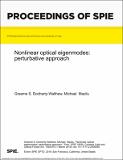Nonlinear Optical Eigenmodes
Abstract
In linear optics, the concept of a mode is well established. Often these modes correspond to a set of fields that are mutually orthogonal with intensity profiles that are invariant as they propagate through an optical medium. More generally, one can define a set of orthogonal modes with respect to an optical measure that is linear in intensity or quadratic/Hermitian in the fields using the method of Optical Eigenmodes (OEi). However, if the intensity of the light is large, the dipole response of an optical medium introduces nonlinear terms to Maxwell’s equations. In this nonlinear regime such terms influence the evolution of the fields and the principle of superposition is no longer valid and consequently, the method of Optical Eigenmodes breaks down. In this work, we define Optical Eigenmodes in the presence of these nonlinear source terms by introducing small perturbation fields onto a nonlinear background interaction and show how this background interaction influences the symmetries associated with the eigenmodes. In particular, by introducing orbital angular momentum (OAM) to the Hilbert space of the perturbation and background fields, we observe conservation laws and symmetries for which we derive associated operators.
Citation
Docherty-Walthew , G & Mazilu , M 2019 , Nonlinear Optical Eigenmodes . in J Glückstad , D L Andrews & E J Galvez (eds) , Complex Light and Optical Forces XIII . , 109351K , Proceedings of SPIE , Society of Photo-Optical Instrumentation Engineers , Complex Light and Optical Forces XIII (SPIE OPTO) , San Francisco , California , United States , 2/02/19 . https://doi.org/10.1117/12.2508300 conference
Publication
Complex Light and Optical Forces XIII
ISSN
0277-786XType
Conference item
Collections
Items in the St Andrews Research Repository are protected by copyright, with all rights reserved, unless otherwise indicated.

